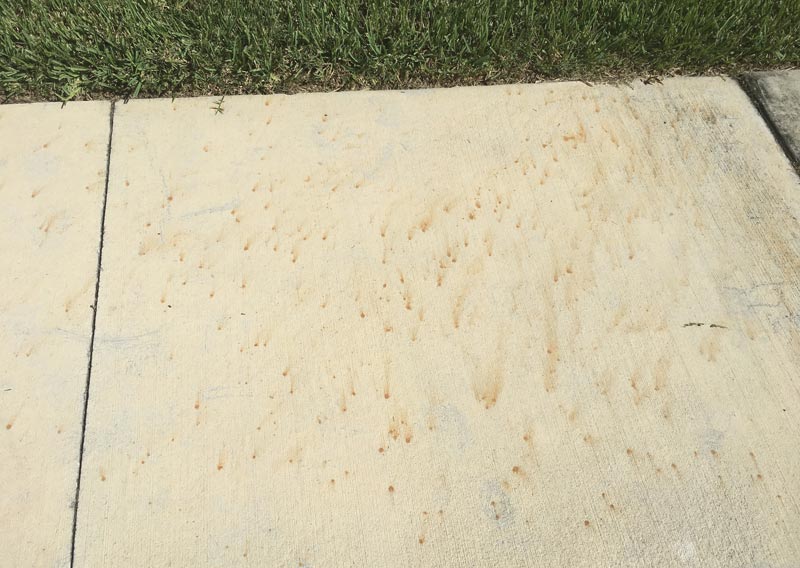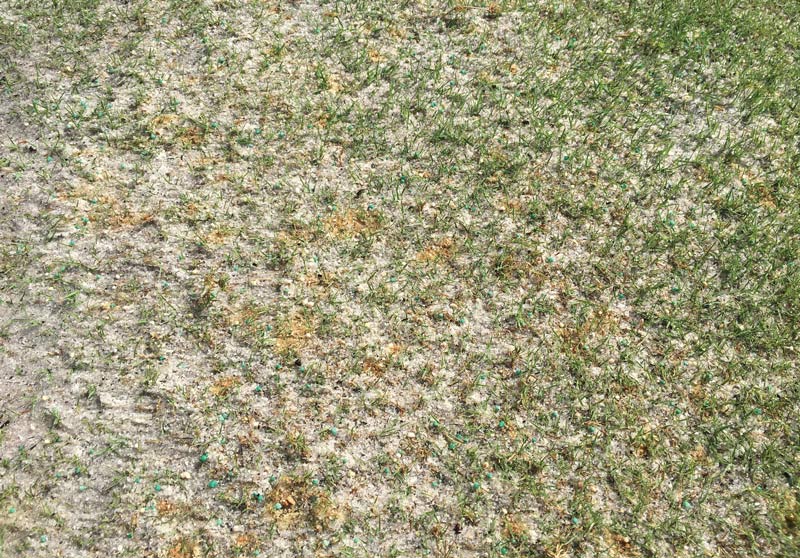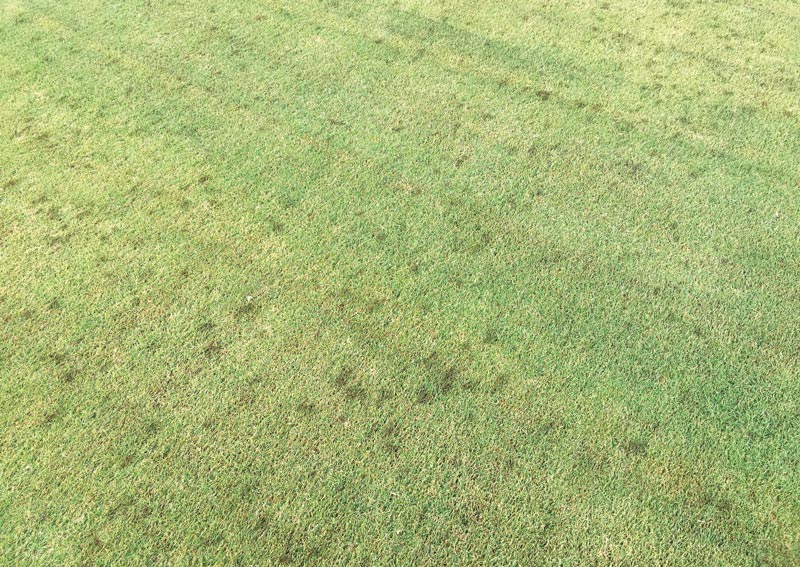
Figure 1. Iron sulfate granules caused stains on this sidewalk. Photos by T. Shaddox
Whether iron is applied for disease suppression or simply to increase greening, it is a common component of many turfgrass nutritional programs. Within the plant, iron plays a key role in photosynthesis via the activity of ferrodoxin, which is an important electron-transfer molecule. In addition, iron is involved in the biosynthesis of chlorophyll — the green plant pigment — and chlorophyll proteins (1). In fact, many of the functions of iron are closely connected to chlorophyll, which is one reason why the application of iron often results in increased greening of the plant.
Previous tests of iron products on turf
Iron may be supplied to turfgrass in several ways through the numerous iron products available in the turf market. These products come in different forms, ranging from fine powder to granular to liquid. Over the past several years, approximately 14 studies have been conducted at the University of Florida testing various iron products applied to turfgrass. The results of these studies were consistent and were based on the form of iron used. For example, turfgrass treated with granular iron did not respond in any of the studies, whereas turfgrass treated with the same iron source in a foliar application responded with increased turf greening.
These different responses lead one to ask, “Why?” If turfgrass responds to liquid iron applied to the leaves, shouldn’t it respond to the same iron applied as a soluble granule to the soil?

Figure 2. Iron sulfate stains can easily be seen on the soil surface when the canopy is thin, as it was during this grow-in.

Figure 3. Iron stains occurring on the turf canopy can be misdiagnosed as disease.
In some cases, the results of granular iron applications may be considered undesirable. Small orange/reddish dots are often observed on cart paths and sidewalks (Figure 1). These stains are the telltale sign of granular iron sulfate that was not removed from the concrete surface and subsequently came into contact with water. The stains are the result of the iron oxidizing into iron oxide, which is the same thing as rust that forms on metal. Interestingly, the same reaction occurs on the soil surface, but it generally goes unnoticed because the turf canopy may obscure the soil (Figure 2). On rare occasions, stains can be observed on the actual turfgrass and may be misdiagnosed as a sign of disease (Figure 3).
The ramifications of these observations are concerning, because granular iron sulfate may be the iron source most commonly applied to turfgrass. This form of iron is soluble and is commonly blended in bulk fertilizer. Thus, it seems reasonable to assume that granular iron sulfate will solubilize, enter the soil solution, be taken up by the turf via root absorption, and result in increased turf greening. However, the 14 studies conducted at the University of Florida simply did not show a response to granular iron sulfate. In those same studies, however, turfgrass plots treated with foliar-applied iron sulfate showed enhanced greening of the turfgrass foliage.
These differing responses lead one to ask: “Is it a waste of time and money to include iron in granular fertilizer blends?” Because turf responded to the same iron source when it was applied to the leaves but not to the soil, the answer was likely a function of soil solubility. Therefore, a comprehensive soil-solubility study was conducted using common iron products available in the turf market. The objective was to determine the solubility of these iron fertilizers when they were applied to 11 soils collected from across the United States.
Materials and methods
Incubation study
An incubation study was carried out to determine how long various iron fertilizers were able to stay soluble in different soils (2). Eleven soils (Table 1) were selected in an attempt to capture the variability in soils across the United States, particularly in regard to pH. The chemical properties of the soils varied greatly, and the pH ranged from 5.1 to 7.9 (Table 2). Most soils were collected from sites where turfgrass was growing. The iron products (Table 3) were selected because each was derived from a different iron source, and they are all available in the turf market.
Each of the 11 soils was weighed in plastic cups and treated with iron from each treatment to provide a loading rate of 0.1 pound of iron per ton of soil (50 milligrams/kilogram). This amount was approximately equal to five applications of a fertilizer containing 6% iron applied at 300 pounds per acre (336.25 kilograms/hectare). The amount of each product incubated was based on the total iron content of each fertilizer as determined by laboratory analysis. Soils were incubated for one hour and one, seven, 14 and 21 days. Immediately following each incubation time, the soluble iron remaining in the soil was extracted and analyzed.
Results and discussion
Iron fertilizers differed in their ability to remain soluble in the soil (Figure 4). Wolftrax, Vigiron, glucoheptonate, sulfate and Sweet Iron did not increase soluble iron at any time in any of the 11 soils. The chelated iron sources increased soluble iron in the soils, and differences among chelates were primarily related to the soil pH. In general, differences between iron sources were consistent when measured in soils of similar pH. Therefore, soils were grouped by pH ranges.
Soils with pH greater than or equal to 7.9
One day after application, the only source that increased soluble iron in soils with pH greater than or equal to 7.9 was EDDHA. These results confirm that iron chelates differ in their ability to withstand displacement of their metal depending on the soil pH. Superintendents dealing with iron deficiency on soils with a pH greater than or equal to 7.9 have two curative options. The first option is to use EDDHA for soil applications or when foliar applications are likely to be washed off the leaves and into the soil. The second option is to avoid soil applications altogether and rely strictly on foliar iron applications.
Soils with pH greater than 7.0 and less than 7.9
In soils with pH greater than 7.0 but less than 7.9, only chelates EDTA, DTPA and EDDHA increased soluble iron in the soil one hour after application. Differences among chelates were small, but EDDHA was found to be superior to all other iron sources after three weeks of incubation.
The ability of chelates to maintain their bond with iron changes rapidly when soil pH reaches 7.0 or above. As soil pH increases and approaches 7.0, iron begins to be displaced from EDTA because of increasing competition from calcium (Figure 5). Iron bound by DTPA may also become displaced, but displacement does not occur to any great extent until the pH increases to 7.5. In contrast, iron bound by EDDHA remains largely unaffected by soil pH. For these reasons, superintendents are advised to find out their soil pH before they decide to purchase iron chelates.
Soils with pH less than or equal to 7.0
When the soil pH was less than or equal to 7.0, application of the marginal soil chelates (citrate and IDHA) resulted in 20% of their iron remaining soluble after one hour. This means that 80% of the applied iron was not available for plant uptake. The percentage of plant-available iron was reduced to approximately 10% after one day. After a week of incubation, soils treated with IDHA contained the same amount of soluble iron as untreated soil.
Marginal chelates, such as iron citrate, are commonly used in foliar applications and have been shown to increase turfgrass greening when applied to turfgrass leaves. However, these results indicate that iron applied as either citrate or IDHA must remain on the foliage to be effective. If the chelates are allowed to be washed into the soil, approximately 90% of the iron will become insoluble during the first 24 hours.
This is in contrast to iron applied as EDTA, DTPA and EDDHA, which increased soluble iron for the entirety of the three-week study. When soil pH was less than or equal to 7.0, differences among chelates were minimal at each measurement time (one hour and one, seven, 14 and 21 days after application), indicating that EDTA, DTPA or EDDHA would be useful iron sources for turfgrass managers who desire to apply iron to the soil.
Conclusion
After application, non-chelated iron sources oxidized into insoluble forms in less than one hour, rendering the iron unavailable. The results of this study do not support the application of iron to soils unless the iron is chelated as EDTA, DTPA or EDDHA. If a cost-effective granular source of one of these three chelates is available, then granular applications of iron may be an effective method of supplying iron. Otherwise, these results indicate that granular iron will be largely ineffective in treating iron deficiency in turfgrasses. Iron chelates other than EDTA, DTPA and EDDHA may also increase soluble iron in soils, but their effectiveness should be confirmed through similar soil incubation studies prior to use.
Closing remarks
Some iron sources that may be applied to soil are actually intended to be applied as a foliar treatment. These products may include sulfate, citrate, polysaccharide and glucoheptonate. Foliar applications of iron circumvent the soil oxidation process and are an effective method of supplying iron. In turfgrass response studies conducted between 2014 and 2018, the foliar application of iron resulted in equivalent turfgrass responses between iron sources regardless of whether the iron was chelated.
Although confirmatory research is needed, these preliminary results indicate that foliar iron sulfate applied with an adjuvant will result in turfgrass greening equivalent to that produced by the more expensive iron chelates. However, if the iron is washed off the leaf and into the soil, non-chelated iron will become insoluble almost immediately. Therefore, foliar-applied iron must be allowed sufficient time for plant absorption before rainfall or irrigation washes the iron off the leaf and into the soil. Future research may determine the precise time required for maximizing foliar iron uptake. Until then, allowing the application to dry for two to four hours is generally sufficient.
Acknowledgments
The authors thank Kaitlyn M. Schoonover and Kathryn M. Shaddox for their assistance in the collection of soils from Colorado and Oklahoma.
The research says ...
- Previous tests of iron products on turfgrass found that turf treated with granular iron showed no response, but greening occurred when turfgrass received foliar applications of the same iron source.
- Ten iron products were tested on 11 soils from areas across the U.S.; each product was derived from a different iron source, and all are available in the turf market.
- Non-chelated iron became insoluble in each soil one hour after soil contact.
- EDTA, DTPA and EDDHA increased soluble iron in the soils, and the influence of chelation was more apparent in soils with pH greater than 7.0.
Literature cited
- Lindsay, W.L., and A.P. Schwab. 1982. The chemistry of iron in soils and its availability to plants. Journal of Plant Nutrition 5:821-840. doi:10.1080/01904168209363012
- Shaddox, T.W., H. Fu, D.S. Gardner, R.M. Goss, E.A. Guertal, W.C. Kreuser, G.L. Miller, B.R. Stewart, K. Tang and J.B. Unruh. 2019. Solubility of ten iron fertilizers in eleven North American soils. Agronomy Journal 111:1498-1505. doi:10.2134/agronj2018.12.0770
- Taiz, L., E. Zeiger, I.M. Møller and A.S. Murphy. 2015. Plant physiology and development. Sixth edition. Sinauer Associates, Sunderland, Mass.
Travis Shaddox is an assistant professor at the University of Kentucky, Lexington, Ky. Hanzhuo Fu is a laboratory manager at the University of Florida’s Fort Lauderdale Research and Education Center, Fort Lauderdale, Fla. David Gardener is a professor at Ohio State University, Columbus, Ohio. Ryan Goss is an associate professor at New Mexico State University, Las Cruces, N.M. Elizabeth Guertal is a professor at Auburn University, Auburn, Ala. William Kreuser is an assistant professor at the University of Nebraska, Lincoln, Neb. Grady Miller is a professor at North Carolina State University, Raleigh, N.C. Barry Stewart is an associate professor at Mississippi State University, Starkville, Miss. Kaiyuan Tang is a graduate student and research assistant at Pennsylvania State University, State College, Pa. J. Bryan Unruh is a professor and associate center director at the University of Florida, Jay, Fla.